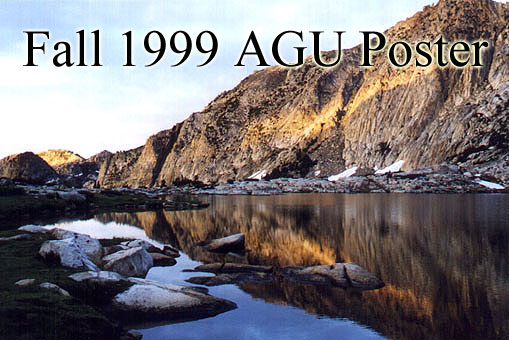Why The Sierras Are So Stressed-Out:
The Effect of Long Valley Caldera
Inflation On Faulting in the Sierra
Nevada |
 |
Authors: Higbee, P.*, Bürgmann,
R.*, Owen, S.E.**, Dreger, D.*
phigbee@seismo.berkeley.edu, burgmann@seismo.berkeley.edu,
owen@terra.usc.edu, dreger@seismo.berkeley.edu
* Geology and Geophysics Dept, University of
California, Berkeley, CA 94720
** Earth Sciences Department, University of Southern
California, Los Angeles, CA 90089
| Since 1978, an area located in
the Sierra Nevada south of Long Valley Caldera, California, (here in called
the Hilton Block) has been one of the most seismically active regions in
California. The patterns of recent earthquake ruptures suggest previously
unrecognized faults with north-south trending, sinistral strike-slip kinematics
that are unusual with respect to the regional kinematics of the Walker
Lane-Eastern California Shear Zone and the Basin and Range. Earthquake
focal mechanisms, the spatial and temporal distribution of microseismicity,
and preliminary investigation of surface lineations due to youthful crustal
fracturing indicate that the Hilton Block is being faulted by a set of
3-5 NNE trending, sinistral strike-slip faults. These faults are bounded
to the N by a NW trending dextral fault at the southern edge of Long Valley
Caldera. The geometry of ruptures in the Hilton Block may be a consequence
of the interaction between the inflation of the Long Valley magma chamber,
regional Basin and Range strain, and pre-existing structural weaknesses.
We evaluate the effects of these deformation sources on the Hilton Block
faults with 3D boundary element models in an elastic half-space. We focus
our studies on the unusual faulting patterns and high rate of seismicity,
which may be attributed to the effects of induced stresses from recurring
magmatic intrusions in the Long Valley Caldera, in conjunction with Basin
and Range stresses acting on a pre-existing NNE-oriented fracture systems
in the eastern Sierra Nevada |
What is the story? |
| Temporal and spatial distribution
of seismic events south of the Long Valley Caldera indicate a correlation
between caldera inflation and seismic activity in the Hilton Block.
Spatial distributions of seismic
events within the Hilton Block indicate at least 3 distinct NNE trending
fault structures and 2 WNW trending lineations.
Focal mechanisms indicate sinistral
motions on the NNE-striking seismic lineaments, whereas the regional tectonics
would suggest Basin and Range normal faulting and/or right-lateral faulting
along the Eastern California Shear Zone
Hilton Block seismic events and
aftershocks do not occur on the Hilton Creek Fault nor the Laurel-Convict
Fault, the major NW trending normal fault structures in this region of
the Sierras.
The 1997 inflationary period within
the caldera appears to have distributed strain to the Hilton Block via
a right-lateral lineation and then further south along the Whisky Creek
Fault, producing normal and left-lateral motions. |
|
|
|
